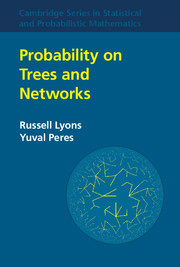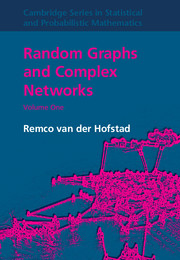Refine listing
Actions for selected content:
1413 results in Ebooks in network science
Comments on Exercises
-
- Book:
- Probability on Trees and Networks
- Published online:
- 19 January 2017
- Print publication:
- 20 January 2017, pp 594-647
-
- Chapter
- Export citation
Preface
-
-
- Book:
- Probability on Trees and Networks
- Published online:
- 19 January 2017
- Print publication:
- 20 January 2017, pp xiii-xvi
-
- Chapter
- Export citation
Chapter 5 - Branching Processes, Second Moments, and Percolation
-
- Book:
- Probability on Trees and Networks
- Published online:
- 19 January 2017
- Print publication:
- 20 January 2017, pp 131-173
-
- Chapter
- Export citation
Chapter 9 - Infinite Electrical Networks and Dirichlet Functions
-
- Book:
- Probability on Trees and Networks
- Published online:
- 19 January 2017
- Print publication:
- 20 January 2017, pp 309-338
-
- Chapter
- Export citation
Chapter 10 - Uniform Spanning Forests
-
- Book:
- Probability on Trees and Networks
- Published online:
- 19 January 2017
- Print publication:
- 20 January 2017, pp 339-387
-
- Chapter
- Export citation

Probability on Trees and Networks
-
- Published online:
- 19 January 2017
- Print publication:
- 20 January 2017

Random Graphs and Complex Networks
-
- Published online:
- 12 January 2017
- Print publication:
- 22 December 2016
Intermezzo: Back to Real-World Networks …
- from Part III - Models for Complex Networks
-
- Book:
- Random Graphs and Complex Networks
- Published online:
- 12 January 2017
- Print publication:
- 22 December 2016, pp 179-182
-
- Chapter
- Export citation
1 - Introduction
-
- Book:
- Random Graphs and Complex Networks
- Published online:
- 12 January 2017
- Print publication:
- 22 December 2016, pp 1-54
-
- Chapter
- Export citation
Glossary
-
- Book:
- Random Graphs and Complex Networks
- Published online:
- 12 January 2017
- Print publication:
- 22 December 2016, pp 304-305
-
- Chapter
- Export citation
Course Outline
-
- Book:
- Random Graphs and Complex Networks
- Published online:
- 12 January 2017
- Print publication:
- 22 December 2016, pp xv-xvi
-
- Chapter
- Export citation
Contents
-
- Book:
- Random Graphs and Complex Networks
- Published online:
- 12 January 2017
- Print publication:
- 22 December 2016, pp vii-x
-
- Chapter
- Export citation
3 - Branching Processes
- from Part I - Preliminaries
-
- Book:
- Random Graphs and Complex Networks
- Published online:
- 12 January 2017
- Print publication:
- 22 December 2016, pp 87-114
-
- Chapter
- Export citation
2 - Probabilistic Methods
- from Part I - Preliminaries
-
- Book:
- Random Graphs and Complex Networks
- Published online:
- 12 January 2017
- Print publication:
- 22 December 2016, pp 57-86
-
- Chapter
- Export citation
Dedication
-
- Book:
- Random Graphs and Complex Networks
- Published online:
- 12 January 2017
- Print publication:
- 22 December 2016, pp v-vi
-
- Chapter
- Export citation
References
-
- Book:
- Random Graphs and Complex Networks
- Published online:
- 12 January 2017
- Print publication:
- 22 December 2016, pp 306-316
-
- Chapter
- Export citation
4 - Phase Transition for the Erdős-Rényi Random Graph
- from Part II - Basic Models
-
- Book:
- Random Graphs and Complex Networks
- Published online:
- 12 January 2017
- Print publication:
- 22 December 2016, pp 117-149
-
- Chapter
- Export citation
Frontmatter
-
- Book:
- Random Graphs and Complex Networks
- Published online:
- 12 January 2017
- Print publication:
- 22 December 2016, pp i-iv
-
- Chapter
- Export citation
7 - Configuration Model
- from Part III - Models for Complex Networks
-
- Book:
- Random Graphs and Complex Networks
- Published online:
- 12 January 2017
- Print publication:
- 22 December 2016, pp 216-255
-
- Chapter
- Export citation
Appendix
-
- Book:
- Random Graphs and Complex Networks
- Published online:
- 12 January 2017
- Print publication:
- 22 December 2016, pp 301-303
-
- Chapter
- Export citation
